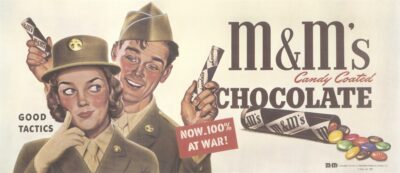
Gone with the Wind is a love story—or, more appropriately, it is a lust story. Scarlett O’Hara’s affection for Ashley was superficial, but her craving for that cad Rhett was untamed, unbridled and straight hunger.
Hunger—both literal and abstract—is a theme prevalent throughout the 1936 novel and the film that came out in 1939. Besides the hunger of love, there’s also the actual hunger that Scarlett O’Hara finds herself suffering in the wake of the Civil War. In chapter 25 of the Margaret Mitchell novel, it reads, “The memory of those savory meals had the power to bring tears to her eyes as death and war had failed to do, had the power to turn her ever-gnawing stomach from rumbling emptiness to nausea.”
That savory meal so vivid in narrator’s memory reads like a veritable all-star team of cuisine from the Old South. From that same chapter:
“Rolls, corn muffins, biscuit and waffles, dripping butter, all at one meal. Ham at one end of the table and fried chicken at the other, collards swimming richly in pot liquor iridescent with grease, snap beans in mountains on brightly flowered porcelain, fried squash, stewed okra, carrots in cream sauce thick enough to cut. And three desserts, so everyone might have his choice, chocolate layer cake, vanilla blanc mange and pound cake topped with sweet whipped cream.”
OK Scarlett, you have my attention. Let’s drill down into that passage until we can taste it.
Rolls, corn muffins, biscuit and waffles
All dripping with butter, indeed. The importance of bread in a southern meal cannot be overstated. It is glutinous and glorious, and precisely what one needs to sop up all that gravy, both brown and white.
Plenty of southern dishes include slices of classic white bread hidden beneath a barbecued slab of meat or half a chicken. Not only does it absorb all that sauce, but it also helps to quell any spiciness in the dish. Corn muffins and biscuits, on the other hand, these should be in a category all their own. Cornbread (or muffins, in this case) are crumbly and gritty, while biscuits are buttery and flaky. Both deserve a spot at any table, southern or otherwise. Freshly baked, there is no match. Particularly biscuits—these dinnertime treats waft an aroma enticing enough to satisfy even the insatiable Miss Scarlett. Then there’s waffles. Its inclusion on a list of bread is a baffling choice and one that makes one bear the weight of a particularly heavy existential question, “what is bread?” Nevertheless, waffle’s affinity for fried chicken makes it a worthy option in this regard.
Ham at one end of the table and fried chicken at the other
A cured, slightly sweet glazed ham is the prosciutto di Parma of Georgia. Whether eaten as the centerpiece of a grand meal or torn from the bone in chunks and layered onto a biscuit, ham is about as southern as it gets. Typically, southern ham is baked, fat side up, with a shimmering glaze of Dijon mustard, brown sugar, thyme and sometimes even cola. And when the oven opens to reveal the prized pig, the glow of the glaze is akin to staring at the sun. And if that doesn’t blind you, the taste very well might. Salty and peculiarly sweet, with a thin layer of fat and crispy outer shell, it’s a roasting pan of southern charm.
Then there’s fried chicken. Bless your heart, fried chicken. The humble dish traces its roots back at least 200 years, arriving on the shores of this country to eventually become a legendary creation and the last meal of choice for professional chefs and common folk alike. Made nationally famous by a recent Kentucky Fried Chicken promotion, “Georgia Gold” fried chicken expands on the lore by featuring a honey-mustard barbecue infusion in the classic recipe. The tangy, flavorful take on chicken draws from both Georgian and South Carolina flavors, for a heady coalescence of crunchy skin, sticky sauce, and deeply succulent meat.
Collards…snap beans…fried squash, stewed okra, carrots in cream sauce
There’s a lot to unpack here in a short amount of space. Collards are of course greens, except lovingly imbued with fat usually from either pork or smoked turkey. Snap beans are just green beans, usually slow cooked with onion, garlic and bacon. Fried squash turns butternut squash into fritters, crispy on the outside, creamy on the inside. Stewed okra breaks down the tough veggie into manageable bites, again, usually paired with pork. Meanwhile, the cream in creamed carrots is often flavored with dill. The greatness of southern cooking is that you can get your veggies without the demoralizing flavor of actual vegetables.
Chocolate layer cake, vanilla blanc mange and pound cake topped with sweet whipped cream
The chocolate cake and pound cake with sweet cream are rather self-explanatory, while the vanilla blancmange is almost like a sweetened milk Jello. Not the most appetizing sweet by the sound of it, but the cooling dessert might be the perfect way to cut through all that southern heartiness.
As Scarlett says right before the intermission in the 1939 film, “As God is my witness, I’ll never be hungry again.”




















